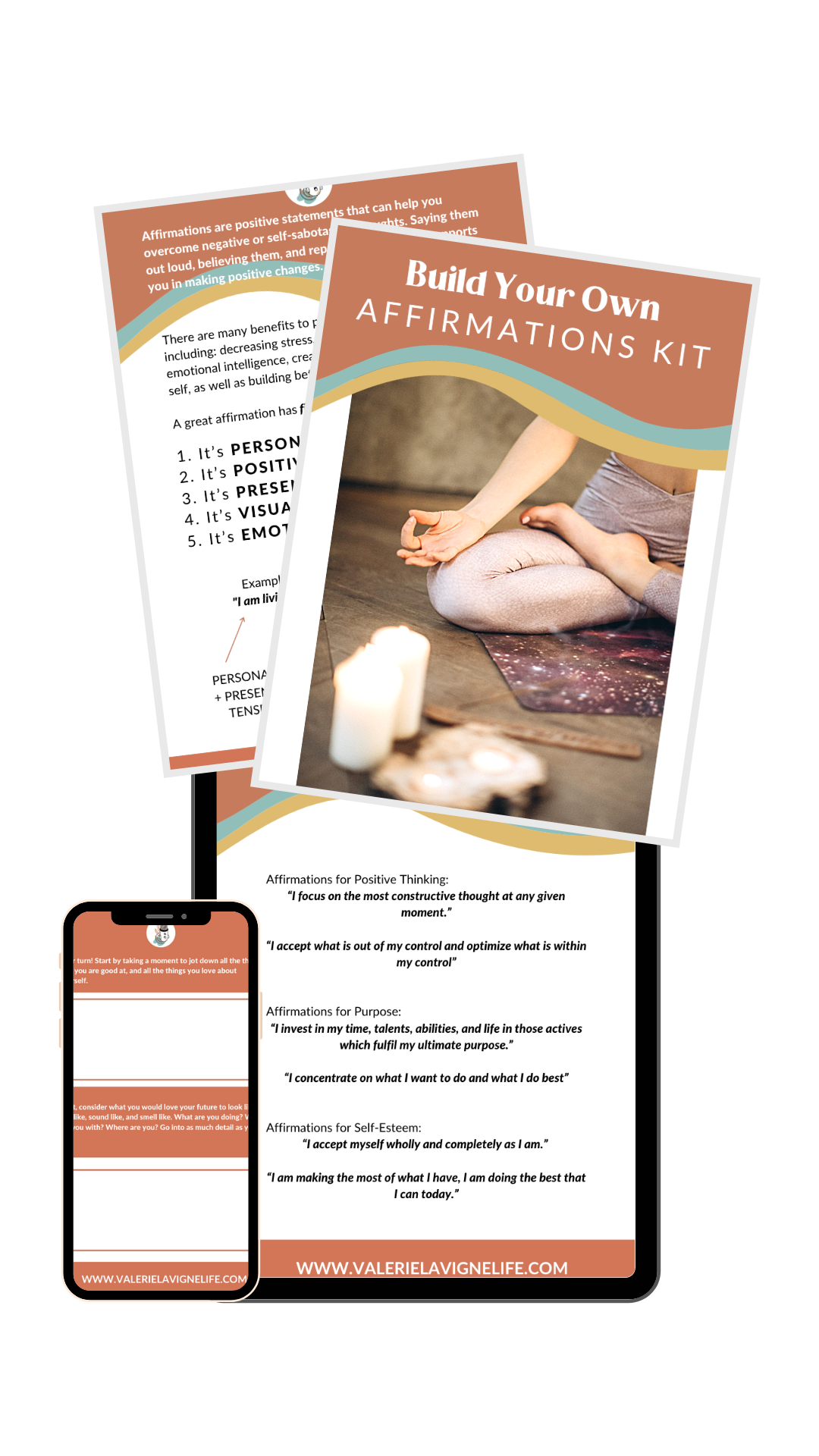E81: 5 Tips for Positive Self-Talk
E81: 5 Tips for Positive Self-Talk
Today’s episode is one of many on this show - where we are talking about mindset, positivity, and confidence...
Leave a review on Apple Podcasts
[00:57] What is self-talk exactly?
Self-talk is the running dialogue in our heads. Have you ever noticed it? Sometimes it’s the little voice that gives us instructions when we’re getting ready for bed, or the chatter in our minds observing our environment, and sometimes it’s singing along to a tune in our head. It’s basically when we’re talking to ourselves in our mind.
Everyone has this inner narrative, but we don’t often spend so much time actually thinking about what the heck it’s going on about. The important truth is that our self-talk has a much bigger influence on the way we see ourselves and the world we live in, than we realize.
[1:45] Negative & Positive Self-Talk
Here’s the thing, we all have negative and positive self talk, which one do you most often use? Knowing the answer to this question can help you start making proactive changes to living your best life.
Unfortunately most of us have negative self-talk patterns. These are the thoughts where we’re focusing on comparing ourselves to others, or when we feel the “not-enoughness.” Our brains remember negative experiences over positive ones, and we tend to replay these messages in our minds, which in turn fuels negative feelings.
Here’s the good news: positive self-talk is the opposite of negative self-talk – I mean duh… but positive self-talk is also possible to make automatic. It’s possible, with practice.
But before we get into all that, I think it’s important to note that positive self-talk is a very kind and confident way of thinking. It’s not about narcissism, but rather thoughts around self-compassion and knowing who you are.
[2:55] Benefits to Positive Self-Talk
Reduces Stress:
When your thinking is more optimistic, this results in more helpful coping strategies when faced with challenges or stressful situations. Negativity is not helping anyone through a challenge. Positivity keeps you open to seeing new possibilities or previously missed opportunities.
Boosts Confidence + Resilience:
Positive self-talk builds confidence and makes you more likely to achieve goals. I hinted before that positive self-talk takes practice, well that effort is simultaneously improving your self-confidence, and when you wake up to the fact that a badass babe is staring back at you in the mirror every morning, that babe knows she’s kicking ass and taking names.
Builds Better Relationships:
Who wouldn’t want to be around someone who is more cooperative and optimistic? Good vibes also rub off on other people. Spread the love + positivity to your friends and family.
[4:00] Hopefully after those three epic benefits you’re thinking, “YES. This is what I need more of in my life and in my mind.” So here are a few examples of positive self-talk:
I have the power to change my mind.
Even though it wasn’t the outcome I hoped for, I learned a lot about myself.
I am capable and strong, I can get through this.
I can’t control what other people think, say or do. I can only control myself.
Attempting to do this work took courage and I am proud of myself for trying my best.
[4:38] Now, the obvious question: “How do we make it all work?”
Here are the 3 steps:
STEP #1: Identify Your Negative Self-Talk Style
Negative self-talk typically falls into one of four categories:
1. Personalizing
ex. Blaming yourself when something goes wrong
2. Polarizing
ex. Seeing two sides only: good or bad; black or white; this or that, and no in between
3. Magnifying
ex.Focusing only on the negative or bad in every situation and dismissing the positive or good
4. Catastrophizing
ex. Expecting the worst, always
STEP 2: Once you’ve identified which category, or categories your thoughts fall into, you can start to swap them to more positive thoughts.
This is where the practice begins. You will start to pay more attention to your inner dialogue and notice when and where you fall into your negative self-talk. Make a note of these in a journal or notebook and begin to rewrite the thought.
For example, if you tend to personalize your negative self-talk, you hear your inner voice say something like, “Darnit! The cookies are burnt! I suck at baking, this is all my fault!” Instead, you could swap it to: “Oh shoot! Looks like this batch got a little burnt, I now know for next time to set my timer earlier” or check the cookies sooner, or whatever. You’re mentioning what you learned from this experience, and how you will take action to do better next time, and you aren’t blaming yourself for an innocent mistake.
STEP #3: Make Your Positive Self-Talk a Habit.
There are many strategies to make this happen, here are some of my favourites:
Put on your “Investigator Hat” and identify self-talk traps
This will be something you want to do every day. Noticing when and where you are falling into the negativity. You are becoming more mindful of your thoughts, actions, and more aware of this inner dialogue.
As you are doing this, you might notice certain situations where you are more likely to cause more negativity. Like when an introvert is attending a networking or social event.
Noticing the “traps” can help us to swap our negative self-talk to something more positive and encouraging.
Use Positive Affirmations
Positive affirmations can be an excellent tool and practice for improving our self-talk. You can practice positive affirmations to set the tone for the day, or to prepare yourself before a self-talk trap.
To support you with this strategy, I have created a free download called “Build Your Own Affirmations Kit” It teaches you how to create custom affirmations and how to really activate the affirmation! Get yours using the big yellow button below!
Keep a Self-Esteem Journal
Journaling can be a very powerful and effective tool for making lasting mindset shifts. One of the reasons why it is so effective is because you are activating multiple parts of your brain when you put pen to paper. And depending on what you’re writing about it can help expand and amplify your topic: like positive self-talk for example.
The two types of journal I recommend is a Gratitude Journal + an Emotions Journal.
The gratitude journal is a list of what you are grateful specifically that day, as well as why you are grateful for it. Recalling your daily gratitudes helps you return to the feeling of gratitude and brings more of what you’re grateful for.
An Emotions Journal has specific prompts that help you investigate your mindset and encourage you to think positively about different parts of your day.
To help you start your emotions journal, here are some prompts:
I felt proud of myself today when I…
The highlight of my day was…
One of my best attributes is…
I am excited about…
My biggest success this week was…
[8:59] Now that we have a better understanding of self-talk and the importance of a more positive mental chatter, here are my Top 5 Tips for Positive Self-Talk!
[9:10] TIP #1 SET HEALTHY BOUNDARIES
When you start to develop more self-awareness and bring more attention to your self-talk, you will also start to notice what areas of your life shed more darkness than light. And with the knowledge that we can only control ourselves, and not the actions of others, we can choose to set healthy boundaries.
This may look like limiting our intake of media and news. I very rarely listen, watch, or read any type of news. It’s been years since I’ve set this boundary for myself and I can most definitely say that my anxiety and negativity have decreased exponentially.
The other, more difficult way of setting boundaries would be to cut the negative people out of your life. This is obviously easier said than done, especially if we live with said person, but spending less time with negative “friends” or coworkers can also be very helpful.
[10:06] TIP #2 PRACTICE MINDFULNESS
Mindfulness is very important whether you tend to have a more positive or negative self-talk. Everyone on the planet could benefit from being more mindful – including the actual planet. There are also many ways to practice mindfulness, like through meditation, journaling – which we discussed earlier in this episode – and also being able to dream and set goals.
Allowing ourselves to dream and visualize the success we want to achieve, can help us see a possible future target. Reaching this target requires a mindfulness practice so that we can stay on track with reaching our goals and achieving success.
[10:50] TIP #3 STAY PRESENT
Dreaming of and visualizing the future is wonderful, but when our mindfulness spirals into negativity, it’s important to come back into the present moment.
And it may not be the future we are nervous about, but perhaps our negative self talk is dwelling on the past. What’s done, is done, and the most important pace we are in is right here and now. This is where we are and what we can control and change.
Comparing ourselves to others is another way we lose sight of ourselves and the present moment. Instead of feeling sad about what we don’t have or who we don’t look like or whatever – we can express happiness and gratitude for what that other person has and also come back to the present and see all the things and people and experiences that we have in our own lives.
One of my favourite ways to get back into the present moment is to be physically active. When I’m lifting weights, practicing yoga, or doing pilates, I have to be connected to my body and my breath. Two very key things that bring your right back into the moment.
The next time you’re feeling anxious about the future, or upset about the past, or feeling any type of scarcity or lack mindset, come back to your breath. Notice your inhalation and your exhalation, even if you just repeat the phrase “I am inhaling [inhale]. I am exhaling [exhale]” until you feel better.
[12:28] TIP #4 LEARN TO LOVE YOURSELF
At the core, positive self-talk is about self kindness and self compassion. Learning to love yourself is the root of your positive self-talk and true happiness.
Forget failure, learn to reframe the idea that failure is a bad thing! It’s actually a learning opportunity, a chance to develop a new skill, and a step forward out of your comfort zone!
Believe in the successes you’ve achieved in life so far – I am sure there are many! Use the memory and evidence of past success to move you forward toward your future goals and dreams.
[13:11] TIP #5 SURROUND YOURSELF WITH POSITIVITY
Life is too short to get caught up in negativity. Learn to laugh at yourself when you make a mistake, find the humour in an otherwise dull situation. Speak positivity when you’re speaking with others, help others when you can.
Write out and post your positive affirmations. And continue to replace your negative thoughts with positive ones.
Believe in yourself – you’ve got this!
Okay, now, you’re om-work! Use the big yellow button below to download your free copy of my Build Your Affirmations Kit and get started today!
Download the FREE Affirmations Kit
Podcast Host
Valerie LaVigne
Valerie is the creator and founder of Valerie LaVigne Life and the Women's Empowerment Show. She helps busy and empowered women create healthy habits so that they can become the best version of themselves and transform their lives. Learn more about Valerie here!







